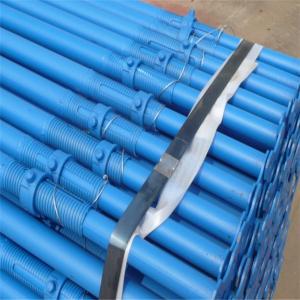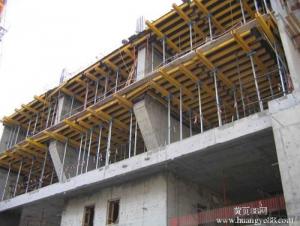Q235/Q345 carbon steel Galvanized adjustable formwork steel props
- Loading Port:
- China Main Port
- Payment Terms:
- TT OR LC
- Min Order Qty:
- -
- Supply Capability:
- -
OKorder Service Pledge
OKorder Financial Service
You Might Also Like
Quick Details
| Brand Name: | Model Number: | ||||
| Material: | Size: | Color: | |||
| Steel Finishing: | Service: | Supplier: | |||
| samples: | samples time: |
Packaging & Delivery
| Packaging Detail: | scaffolding prop adjustable steel props packing : in bulk ,in bundle or as your request |
| Delivery Detail: | within 25-30 days after getting the payment-scaffolding prop adj |
Specifications
Galvanized adjustable formwork steel prop
1.48/60mm,48/56mm,40/48mm
2.a support tool for work
3.adjustable
4BV certification
Q235/Q345 carbon steel Galvanized adjustable formwork steel props
Company introduction :
we are one of the biggest supplier of scaffolding platforms in China, major engaging in all kinds
of scaffolding manufacturing and exporting. We have two self-owned factories which located in
Bazhou city Hebei province and Tianjin jinghai county. We provide Ringlock, Frame style,
cuplocked scaffoldings, and various of walking boards.
For the past 10 years we mainly deal with the OEM works for our overseas costomers and now
we are engaging in exploring the global market based on the support of our old friendship
customers from Southeast Asia.
1. specifications of Galvanized adjustable formwork steel props
1). Material: international standard material Q235 or Q345 high strength bear capacity .
2). Surface treatment: painting, powder coating, pre-galvanized, hot dip galvanized .ele-galvanized
3). Type: light duty / medium duty / heavy duty .
4). Diameter of inner tube :40mm ,48mm.
5). Diameter of outer tube : 48mm , 56mm , 60mm .
6). wall thickness : 1.8mm ,2.0mm ,2.2mm ,2.4mm .
7). adjustable length :
heavy duty :1800-3200mm ,2100-3400mm ,2200-3900mm , 2200-4000mm , 3000-5000 mm,3500-4000 mm.
light duty : 1600-3000mm ,1800-3500mm ,2000-3500 mm .
8). shape of base plate : flower or square .
9). base plate : 120*120*4 mm / 4.5mm / 5mm , 150*150*6mm .
10). type : with hands cup or open thread .
11). OEM serve is available .
2. the Conventional Specification of Q235/Q345 carbon steel Galvanized adjustable formwork steel props :
Heavy Duty Galvanized adjustable formwork steel prop
Min | Max | Internal tube | External Tube |
1.8m | 3.2m | 48mm x 2.0mm | 60mm x2.0mm |
2.1m | 3.4m | 48mm x 2.0mm | 60mm x2.0mm |
2.2m | 3.9m | 48mm x 2.0mm | 60mm x2.0mm |
2.4m | 3.9m | 48mm x 2.0mm | 60mm x2.0mm |
3.5m | 4.0m | 48mm x 2.0mm | 60mm x2.0mm |
3.0m | 5.0m | 48mm x 3.5mm | 60mm x3.5mm |
Other sizes are also available at the buyer’s option | |||
formwork steel prop
Min | Max | Internal tube | External Tube |
1.6m | 3000 | 40mm x 2.0mm | 48mm x2.0mm |
3000 | 48mm x 2.0mm | 56mm x 2.0mm | |
1.8m | 3500 | 40mm x 2.0mm | 48mm x2.0mm |
3500 | 48mm x 2.0mm | 56mm x 2.0mm | |
2.0m | 3500 | 40mm x 2.0mm | 48mm x2.0mm |
3500 | 48mm x 2.0mm | 56mm x 2.0mm | |
Other sizes are also available at the buyer’s option | |||
| 1 | OUTER TUBE | Ø60/ ± 0.3*2(TH)/ ± 0.1 |
| 2 | TUBE | Ø48/ ± 0.3*2(TH)/ ± 0.1 |
| 3 | INSIDE TUBE | Ø60/ ± 0.2*3(TH)/ ± 0.1 |
| 4 | NUT | CASTING IRON |
| 5 | BASE PLATE | 120/ ± 1*5 (TH)mm/ ± 0.2 |
| 6 | TOP PLATE | 120/ *± 1*5(TH)mm/ ± 0.2 |
| 7 | LOCK PIN | Ø12± 0.4 |
- Q: How do you ensure proper load distribution when using steel props?
- Proper load distribution when using steel props can be ensured by following a few key steps. Firstly, it is important to accurately calculate the load-bearing capacity of the steel props and ensure that they are suitable for the particular load they will be supporting. Secondly, the props should be positioned at regular intervals along the load-bearing structure, ensuring that the load is evenly distributed across all the props. Additionally, using proper bracing and diagonal supports can help maintain the stability and distribute the load effectively. Regular inspections and maintenance of the props are also crucial to ensure their structural integrity and load distribution capabilities.
- Q: The steel support used in the building template, I would like to know how it is. If there are relevant specification documents, trouble.
- Provide a combination of steel formwork, composite wood formwork turnover rate and loss rate for reference:Tool type steel template, composite wood template: turnover number 50, construction loss of 1%;Fixture: turnover of 20, sporadic construction loss 2%;Steel support system: turnover number 120, construction loss of 1%;
- Q: What are the common accessories available for steel props?
- Steel props can be enhanced in functionality and safety with various common accessories. These accessories consist of: 1. Utilizing prop heads: These provide a stable surface for supporting beams or other structural elements. The adjustable prop heads easily attach to the steel props. 2. Employing prop connectors: These join multiple steel props together, allowing for longer spans or supporting structures. They ensure a secure connection, increasing stability and load-bearing capacity. 3. Implementing adjustable base plates: These plates attach to the bottom of the steel props, offering a wider surface area for load distribution. They can be adjusted to accommodate uneven ground or achieve the desired height. 4. Incorporating guardrails: Guardrails are essential safety accessories that prevent falls from elevated platforms. They create a barrier around the working area, reducing accidents and providing a safe environment. 5. Utilizing prop sleeves: These sleeves protect steel props from damage during transportation or storage. Designed to fit snugly, they prevent scratches, dents, or corrosion. 6. Employing prop pins and clips: These small accessories secure the adjustable parts of steel props, preventing accidental movement or collapse and ensuring structural integrity. 7. Implementing prop braces: Braces provide additional support and stability for steel props, especially when facing heavy loads or extreme conditions. 8. Utilizing prop storage racks: These racks are specifically designed for storing unused steel props. They organize and protect props, prolonging their lifespan and ensuring easy accessibility. These accessories not only enhance the performance and versatility of steel props but also contribute to overall construction site safety. It is crucial to select appropriate accessories based on project requirements and ensure proper installation and maintenance.
- Q: Can steel props be used for temporary support during tank installation?
- Steel props are indeed capable of offering temporary support during tank installation. They are frequently employed in construction to provide temporary support to structures like walls, ceilings, and floors. These props can be effortlessly adjusted to the desired height and are easily installed and removed, thereby making them an optimal choice for temporary purposes. In the case of tank installation, steel props can be utilized to offer supplementary support, thereby ensuring stability and security throughout the installation procedure. Nonetheless, it is crucial to have professionals properly design and install the steel props to guarantee the safety of the installation process.
- Q: What are the common sizes of steel props available in the market?
- The market offers a variety of steel prop sizes, which can differ based on the region and construction industry requirements. However, there are a few standard sizes that are commonly found across different markets. One frequently used steel prop size is Size 0, which typically allows for an adjustable height range of 1.75 to 3.12 meters. This size is commonly utilized for lighter loads and situations where a smaller prop is sufficient. Another popular size is Size 1, which generally provides an adjustable height range of 2.0 to 3.5 meters. This size is suitable for medium loads and is commonly employed in various construction projects. For heavier loads and larger construction projects, Size 2 steel props are commonly used. This size usually allows for an adjustable height range of 2.5 to 4.5 meters. Size 2 props are often preferred due to their higher load-bearing capacity and stability. Furthermore, specialized steel props are available in the market to cater to specific requirements. These may include larger sizes or props designed for unique applications like underpinning or formwork support. It is important to note that these sizes may vary slightly depending on the manufacturer and region. Therefore, it is crucial to consult a reputable supplier or manufacturer to determine the specific sizes available in your market.
- Q: How many tons of steel support
- The excavation of the foundation pit is divided into 3 large mechanical excavation and the 1 Artificial Excavation of the bottom of a total of 4 steps: (1) the first layer of the main use of short arm excavator excavation, excavation to the ground under the 0.9m, the erection of the first support.
- Q: What are the common sizes of steel props?
- The common sizes of steel props typically range from 1.8 meters to 5 meters in length, with adjustable heights varying from 1.1 meters to 4.8 meters.
- Q: What is the typical lead time for ordering steel props?
- The typical lead time for ordering steel props can vary depending on several factors such as supplier availability, quantity requested, and shipping logistics. However, in general, it can range from a few days to a few weeks. It is recommended to contact the supplier directly for accurate and up-to-date lead time information.
- Q: How to reinforce the lower part of the steel structure of the construction elevator on the roof of the non - air defense garage
- The channel is divided into ordinary channel steel and light channel steel. Hot rolled ordinary channel specification is 5-40#. By the supply and demand sides of the agreement to provide hot rolled flexible channel specifications for 6.5-30#. Channel steel is mainly used in building structure, vehicle manufacturing, other industrial structure and fixed disk cabinet, etc..
- Q: Do steel props have any safety certifications?
- Steel props have safety certifications, ensuring their strength, stability, and reliability. These props, also known as adjustable steel acrow props or shore props, are commonly used in construction projects to temporarily support structures. They are designed and manufactured in compliance with safety standards and regulations. National or international standards organizations, such as the BSI or CEN, set specific safety requirements for steel props in many countries. These standards outline minimum performance criteria, material specifications, and testing procedures that steel props must adhere to in order to obtain safety certifications. For example, in the United Kingdom, steel props must comply with BS 4074:1982, which specifies requirements for temporary support in construction. Similarly, in Europe, steel props must meet EN 1065, providing guidelines for their design, testing, and safe use. Manufacturers undergo rigorous testing and quality control processes to obtain safety certifications. These certifications ensure that the props can withstand required load capacities, have appropriate locking mechanisms, and are made from high-quality materials suitable for construction environments. Regular inspections and maintenance are required to ensure continued safety and reliability of steel props. This includes checking for signs of wear, damage, or deformation that could compromise their structural integrity. Therefore, it is crucial to choose steel props with appropriate safety certifications for construction projects. Following the manufacturer's instructions for installation, adjustment, and dismantling is essential to maintain the safety of the props and the overall integrity of the construction site.
Send your message to us
Q235/Q345 carbon steel Galvanized adjustable formwork steel props
- Loading Port:
- China Main Port
- Payment Terms:
- TT OR LC
- Min Order Qty:
- -
- Supply Capability:
- -
OKorder Service Pledge
OKorder Financial Service
Similar products
Hot products
Hot Searches
Related keywords

























